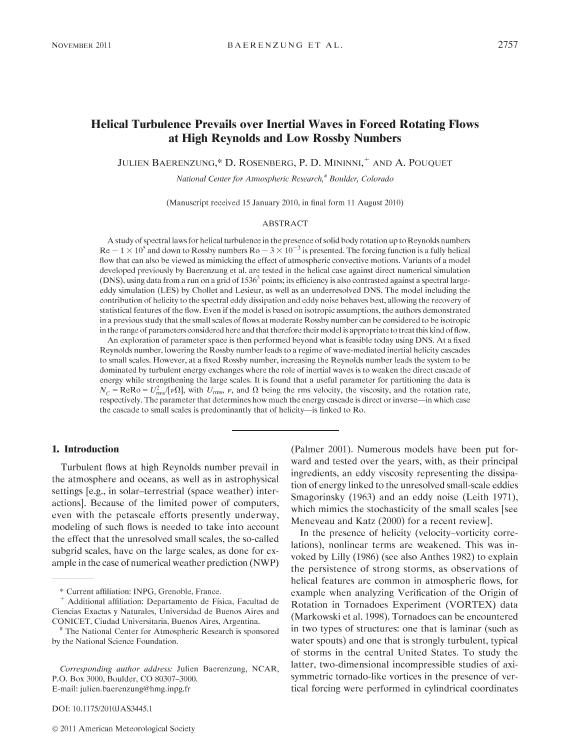Artículo
Helical turbulence prevails over inertial waves in forced rotating flows at high reynolds and low rossby numbers
Fecha de publicación:
10/2011
Editorial:
American Meteorological Society
Revista:
Journal of The Atmospheric Sciences
ISSN:
0022-4928
Idioma:
Inglés
Tipo de recurso:
Artículo publicado
Clasificación temática:
Resumen
Astudy of spectral laws for helical turbulence in the presence of solid body rotation up to Reynolds numbers Re ~ 1 × 105 and down to Rossby numbers Ro ~ 3 × 10-3 is presented. The forcing function is a fully helical flow that can also be viewed as mimicking the effect of atmospheric convective motions. Variants of a model developed previously by Baerenzung et al. are tested in the helical case against direct numerical simulation (DNS), using data from a run on a grid of 15363 points; its efficiency is also contrasted against a spectral largeeddy simulation (LES) by Chollet and Lesieur, as well as an underresolved DNS. The model including the contribution of helicity to the spectral eddy dissipation and eddy noise behaves best, allowing the recovery of statistical features of the flow. Even if the model is based on isotropic assumptions, the authors demonstrated in a previous study that the small scales of flows at moderate Rossby number can be considered to be isotropic in the range of parameters considered here and that therefore theirmodel is appropriate to treat this kind of flow. An exploration of parameter space is then performed beyond what is feasible today using DNS. At a fixed Reynolds number, lowering the Rossby number leads to a regime of wave-mediated inertial helicity cascades to small scales. However, at a fixed Rossby number, increasing the Reynolds number leads the system to be dominated by turbulent energy exchanges where the role of inertial waves is to weaken the direct cascade of energy while strengthening the large scales. It is found that a useful parameter for partitioning the data is NC = ReRo = U2rms/[vΩ], with Urms, ν, and Ω being the rms velocity, the viscosity, and the rotation rate, respectively. The parameter that determines how much the energy cascade is direct or inverse-in which case the cascade to small scales is predominantly that of helicity-is linked to Ro. © 2011 American Meteorological Society.
Palabras clave:
Model Comparison
,
Numerical Analysis/Modeling
,
Turbulence
Archivos asociados
Licencia
Identificadores
Colecciones
Articulos(IFIBA)
Articulos de INST.DE FISICA DE BUENOS AIRES
Articulos de INST.DE FISICA DE BUENOS AIRES
Citación
Baerenzung, Ulien; Rosenberg, Duane; Mininni, Pablo Daniel; Pouquet, A.; Helical turbulence prevails over inertial waves in forced rotating flows at high reynolds and low rossby numbers; American Meteorological Society; Journal of The Atmospheric Sciences; 68; 11; 10-2011; 2757-2770
Compartir
Altmétricas




